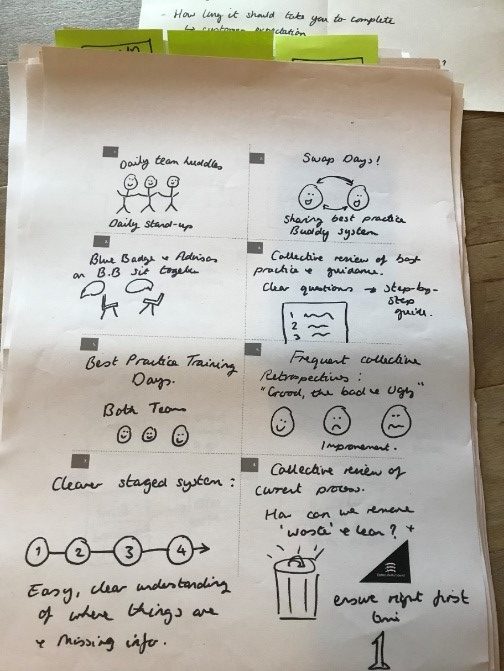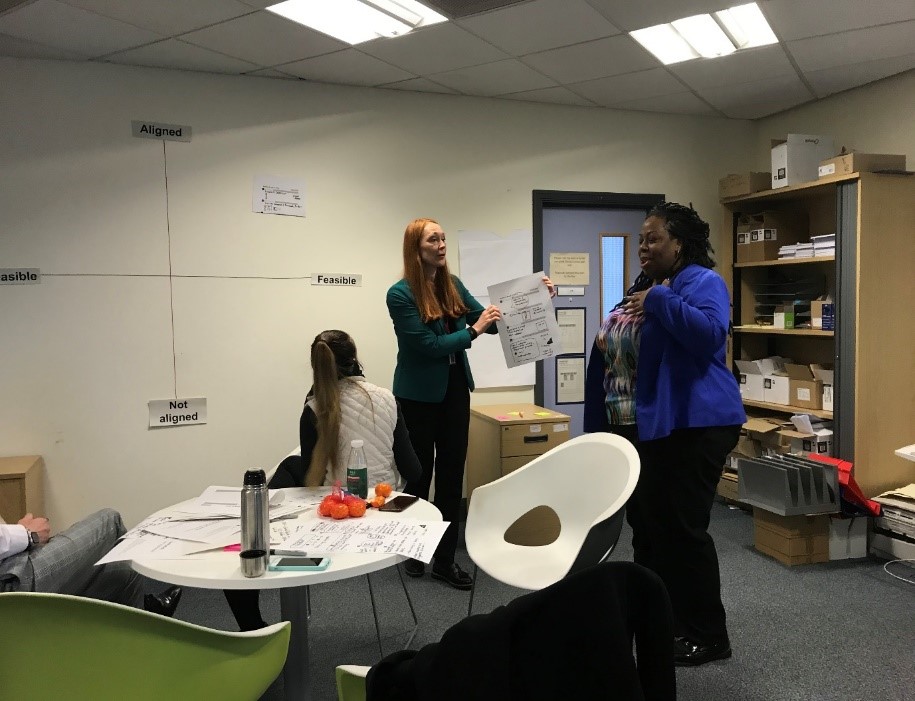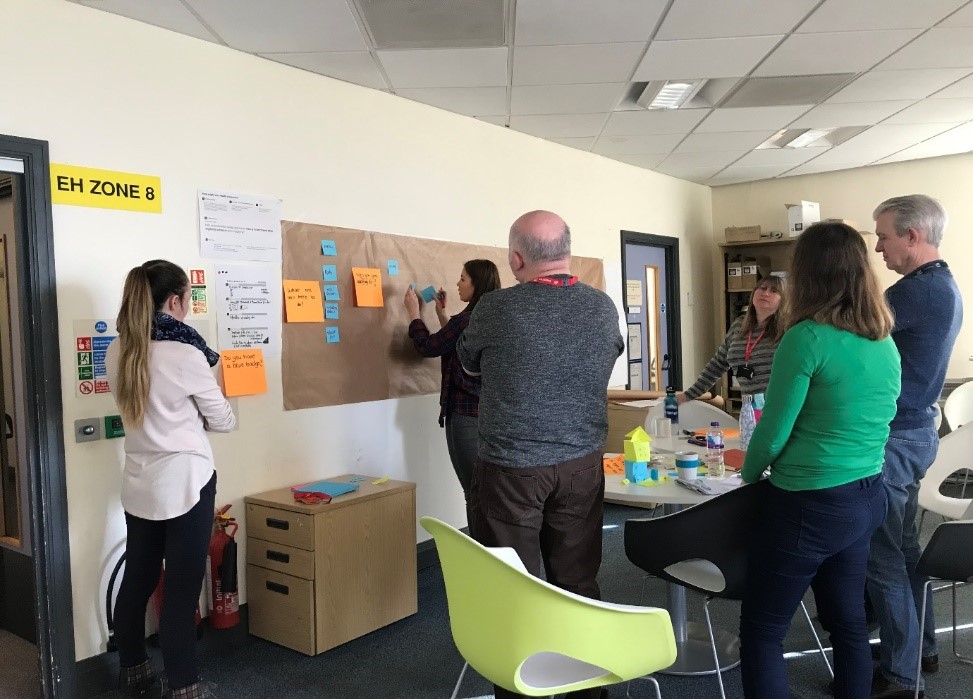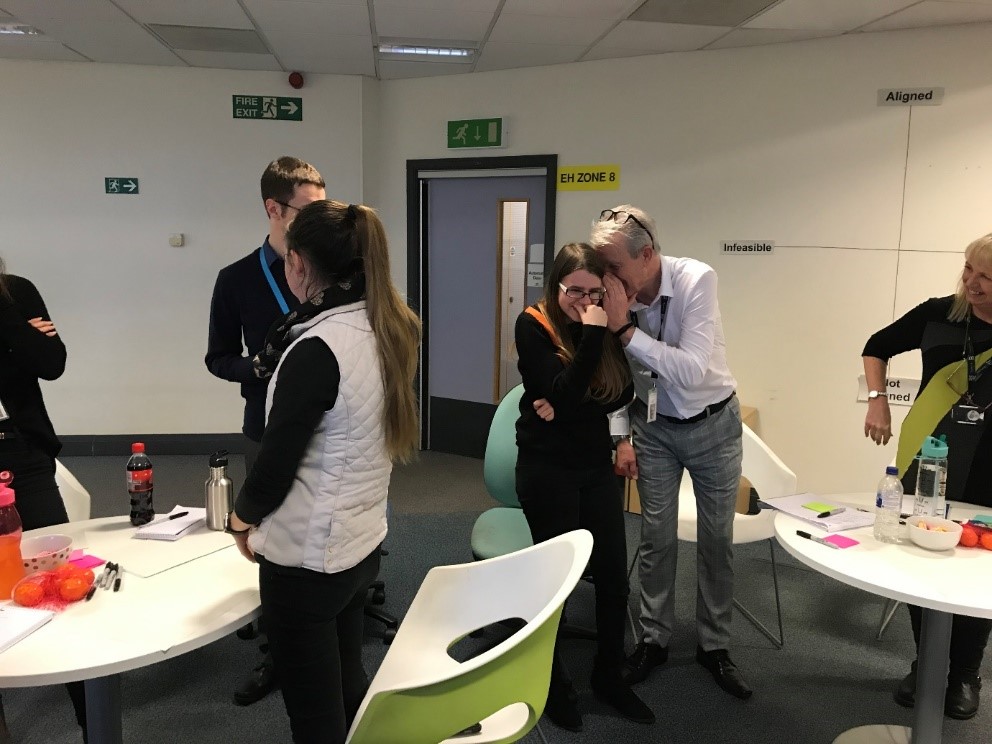Just before lockdown, Caroline McCabe interviewed Bhupinder Mann, Service Designer and Natalie Carron, Customer Service Specialist on ‘How to conduct an effective service design workshop.’ It resulted in some valuable insights.
The challenge
A recent challenge put to our service designers was ‘how to conduct an effective service design workshop, with staff from one of our busiest service areas – our call centre staff and Blue Badge advisors?’
This proved to be tricky, as it wasn’t possible for all advisers to be present at all times and was limited by the amount of time they could be away from the phones.
Quick, short bursts of activity
“We know that Rome wasn’t built in a day, so we decided to go with fast, but effective 90 minute bursts of activity – over 4 sessions, in one day,” said Bhupinder. “Whilst we initially thought that this was a bit of a hindrance – it actually turned out to be a blessing in disguise, as this was one of the most fun and productive workshops I have ever experienced,” she added.
Build the trust
“Our aim at the beginning of the day was to build the relationship between us and the participants, to gain their trust and confidence. We wanted to make it as enjoyable as it could be, using different tactics, such as sketching and fun games to open up our minds to think creatively. We seized on this chance to get people away from their normal routines, give them permission to step away from their laptops, do something different,” explains Bhupinder.
Natalie Carron is a Customer Specialist in the Blue Badge team. She participated in the workshops, alongside some of her colleagues and staff from the Contact Centre. It was a rare chance to step away from the phones, the queries and their laptops. Natalie said it was quite uncommon for anyone of her team or the contact centre team to be involved in a workshop like that before.
So what motivated Natalie to get involved? “The fact that you guys were super enthusiastic, it showed you cared, you wanted to be there. I felt that you genuinely wanted to help us. We thought that maybe this time we can make a difference.”
Give a sense of ownership
Unpicking the ‘magic’ that went on that day, Bhupinder told me that first of all, the role of the designer was just to facilitate. The participants were the developers, the subject matter experts. They had all the knowledge. They were allowed to take an idea and build it from scratch. This gave the teams a sense of ownership of the problems and what could be done about it.
She continues, “We explored their daily struggles and gave them a safe space to express how they were feeling. They are the ones who know the problems the best. They deal with the customers every day. They often know where the solution lies.”
Create the right conditions
To create the right conditions, everyone had to follow a simple set of rules. These included things like no laptops or phones, no talking over each other, no shooting down other people’s ideas.
Each workshop started with a brief introduction to the problem, using one of the four How Might We (HMW) statements. For example, ‘How might we help potential blue badge applicants clearly understand their eligibility criteria before applying?’ This allowed the group to flip the problem into an opportunity for design. Each workshop was designed to explore one of the 4 major problems that had been identified in the customer journey.
Think like a user
This was then followed by a warm up session, designed to put the participants into the shoes of users. They were made to think as users:
- when was the last time we applied for something?
- was it a good or bad experience for us?
- what can we take from it to say ‘that’s really important to us as users?’
Once they had decided on these, they then became the principles that were used throughout the workshops. Things like using clear language, presentation, setting expectations, frequent communication and simple systems.
Ideation is fun
From there they jumped into some fun ideation sessions. The facilitators got the group to draw, sketch and even build a thing out of post it notes. Crazy 8’s got the creative juices flowing, and some (almost) fine art was produced.

Build it, break it, fix it, pitch it
The group then partnered up and picked an idea. They were encouraged to build it, break it, fix it, pitch it.
This allowed the group to see that ideas, which might look easy on the surface, but might not be feasible once you delve in further.

Once this was over, each pair stood up and talked about their idea for 8 to 10 minutes. They then plotted the ideas on a matrix and asked questions like, ‘Does it align to our goals?’ ‘Is it feasible?’
Finally, each pair were asked to pick one idea that they wanted to focus on, which they then built further. For example, designing the flow of an eligibility checker using post-its and brown paper.

Lastly, they played a game of whispers to try and illustrate how difficult it is to get information shared consistently across several teams.

Reflections
Reflecting on the day, Natalie said, " We've never had such productive sessions when trying to find ways to improve the process. The workshops that were set up have been fantastic and it allowed everyone to be involved. Some members of the team have been in the Blue Badge team for 10 years or more and have commented on how grateful they were to have been asked to really be involved - it was the first time that's happened.”
Feedback from the participants on the day, included:
“I actually thought all the elements were helpful - games got you in the right mindset”
“Crazy 8’s were really good because…I came up with ideas really quickly”
“I loved the build it, break it, fix it, pitch it sessions the most”
“All the ideas were good..felt comfortable with fixing one thing well, rather than too many…we don’t want to spread ourselves too thin…risk is we do nothing”
“Made us feel comfortable by being more focused”
“The creative design process – left brain vs right brain”
“It felt like something happened at the end of it – like here’s a set of ideas at the end of the day..”
“It felt like it was super productive, there was momentum with all players around the table for sign off..”
“Not overpowered by super senior people…these are people who work with the customer. every day”
“Everyone knew exactly what they were doing..with the freedom to explore an idea”
“Creating the right space..right mix of people who need to be a part of ideation”
And a few final words from Natalie, “It has boosted morale within the team and allowed people to feel like their opinion and input is valued. We have found real tangible ways to improve the process and the team are excited to see how far we can take this."
Leave a comment